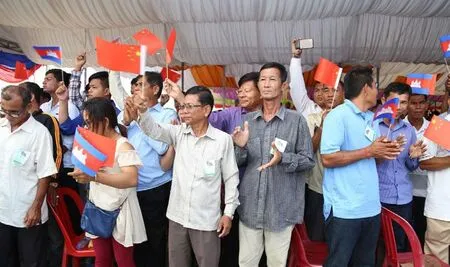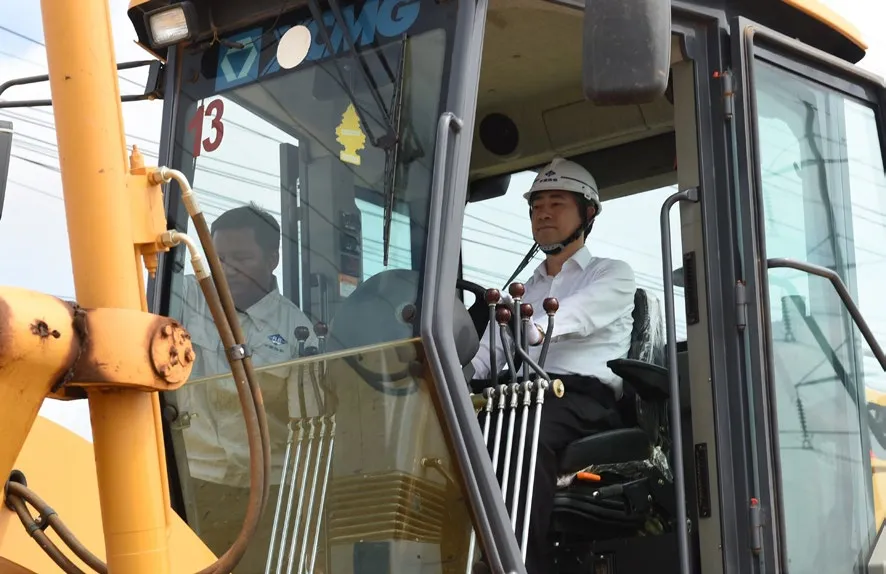ERA OF DEEPER SINO-CAMBODIAN COOPERATION
2018-07-28ByPanYingqiu
By Pan Yingqiu

“Chinese government speaks less and works more,”declared Cambodian Prime Minister Hun Sen on May 7 while presiding over the groundbreaking ceremony for the China-funded reconstruction and expansion of National Road 3 in Cambodia.
Hun Sen emphasized that aid projects sponsored by the Chinese government have improved the infrastructure in Cambodia,promoted economic growth and created more jobs for local residents.
Chinese Ambassador to Cambodia Xiong Bo recounted the numerous groundbreaking and opening ceremonies for roads, bridges and universities that China and Cambodia have shared since February, which evidence the strong momentum and fruitful results of friendly cooperation between China and Cambodia. China is convinced that the upgrade and reconstruction of National Road 3 will play an important role in driving the economic and social development of provinces along the road.
Tangible Benefits
A Chinese saying goes, “If you want to become rich, build a road first,” and in Cambodia they say, “Where there is a road,there is hope.” Both China and Cambodia are presently at a critical stage of development as the two countries both face similar tasks of comprehensively deepening reform, expanding opening to the outside world and optimizing industrial structure.Pragmatic cooperation will lead to many benefits shared by the two countries.
Bringing “tangible benefits”to the peoples of both China and Cambodia was repeatedly mentioned by Chinese President Xi Jinping during his visit to Cambodia in 2016. President Xi emphasized that the traditional friendship between China and Cambodia has been progressing because it depends on practical work and seeks practical benefits.During the trip, President Xi delivered a written speech at the airport, met with King Norodom Sihamoni and held a meeting with Prime Minister Hun Sen.
President Xi also joined Prime Minister Hun Sen in witnessing the signing of a total of 31 bilateral cooperation documents. The cooperation agreements cover a variety of fields including diplomacy, security, joint construction of the Belt and Road, farmland power supply,water irrigation, construction of airports, power stations, power grids and hospitals, rice export to China and tariff elimination on some products.
Before Xi’s visit to Cambodia,the combined length of highways China had either planned or built in Cambodia reached more than 2,600 kilometers, accounting for more than 35 percent of the country’s total road length. Seven large bridges built by China have a combined length of more than 7 kilometers and span the banks of the Mekong River and the Tonle Sap River. A total of six hydroelectric stations built by Chinese companies now operate in Cambodia. Combined power generation from the six hydropower plants accounts for more than 50 percent of the nation’s total. Cambodia has evolved from a lack of electricity all year to a shortage of electricity during the dry season, and now to a surplus to be exported during rainy season. The 11 large-scale water conservancy facilities built by Chinese companies in Cambodia have irrigated over 90,000 hectares of fertile land.
National Road 3, which just started construction in May, is a national highway of Cambodia with a total length of 202 kilometers. It begins from the west side of Pochentong International Airport in Phnom Penh and runs along the coast to the South, eventually connecting with National Road 4. Its reconstruction totals a length of approximately 135 kilometers. The Chinese government provided concessional loans, and China Road & Bridge Corporation (CRBC)is responsible for construction.
Since the establishment of the diplomatic relations between China and Cambodia in July 1958, bilateral economic and trade relations have continued to develop. In 1996, the two countries signed a trade agreement and an investment protection agreement.
Since 2004, the two sides have signed a total of 72 cooperation agreements and documents concerning infrastructure construction, development and utilization of hydraulic resources,information technology, energy utilization, connectivity planning and medical care.

Local residents at the groundbreaking ceremony for the China-funded reconstruction and expansion of National Road 3 in Cambodia on May 7.
Aid projects sponsored by the Chinese government have improved the infrastructure in Cambodia, promoted economic growth and created more jobs for local residents.
According to thePublic Investment Program for 2018 to 2020issued by the Cambodian government, investment in infrastructure in the country will account for 25 percent of the total investment in the next three years. China’s investment in Cambodia primarily focuses on hydroelectric stations, power grids, telecommunications,service industries, textiles,agriculture, medicine and energy.
China Huadian Corporation Ltd., which focuses on energy,Sinohydro Corporation, China Datang Corporation (energy),Hodo Group (garments, rubber tires, bio-pharmaceuticals and real estate), China Duty Free Group and Cambodia Bayon Airlines (the first foreign-based Chinese airline)have already launched investment projects in Cambodia. Among them, Sihanoukville Special Economic Zone (SSEZ), is one of the first overseas economic and trade cooperation zones approved by China’s Ministry of Commerce(MOC).
Docking Development Strategies
Over the past 60 years,friendship between China and Cambodia and the pursuit of common development have benefited both sides. Today,China is securing a decisive victory in building a moderately prosperous society in all respects,and Cambodia has also reached a critical period in advancing theCambodia Industrial Development Policy 2015-2025.
“The ‘Belt and Road Initiative’aligns well with Cambodia’s own national development plans,especially the third phase of the ‘Rectangular Strategy’ that the Cambodian government is currently advancing,” declared Prime Minister Hun Sen,highlighting the significance of the Belt and Road on the common development of China and Cambodia.
The “Rectangular Strategy” is an important plan to guide the direction of Cambodia’s national economic development. In 2004,the Cambodian government proposed the Strategy with focus on optimizing administrative management at the core alongside accelerating agricultural development, strengthening infrastructure, attracting more investment and developing human resources to promote economic growth, create more jobs and ensure social equality and justice through effective management and in-depth reform. Since China proposed the Belt and Road Initiative in 2013, it has achieved efficient docking of the Initiative with the “Rectangular Strategy” in realms of agriculture, energy and transportation, which has unleashed the potential of the complementary economic advantages of the two countries.
Aun Pornmoniroth, Senior Minister of Economy and Finance of Cambodia, noted that China brings not only investment, but also advanced management experience,cutting-edge technologies, as well as expertise, especially in infrastructure. He called China a provider of knowledge and wealth and predicted the Belt and Road to help facilitate Cambodia’s economic and social development in the medium and long term. In particular, connectivity projects will help reduce transportation costs, expand trade, accelerate trade flow and expand logistics coverage. It is also conducive to promoting the joint development of tourism projects and cooperation between financial institutions as well as expanding the exchanges of experience and technologies between Cambodia and China in multiple areas.

Chinese Ambassador to Cambodia Xiong Bo operates a backhoe at the groundbreaking ceremony for the China-funded reconstruction and expansion of National Road 3 in Cambodia, on May 7.
According to China’s MOC,China will actively promote trade cooperation with Cambodia and encourage Chinese companies to increase imports from Cambodia to promote more balanced trade.Sino-Cambodian trade is currently dominated by Chinese exports to Cambodia, and the volume of imports from Cambodia is far smaller. This situation not only indicates considerable potential for Cambodian current economic development, but aligns with the strengths of Chinese enterprises and the long-term focus of Sino-Cambodian cooperation.
A senior editor atKhmer Timesexpressed deep feelings about the economic and trade cooperation between China and Cambodia because as a representative from Cambodian media, he participated in a media event themed around China-ASEAN jointly building the 21st-Century Maritime Silk Road. He expressed that bilateral relations have been improving steadily in recent years with an increasing number of Chinese enterprises investing in Cambodia.
“I see China in a completely different light now—not only have its economy and society developed rapidly, but it is also playing an increasingly important role in international affairs,” he declared. “I hope that Cambodia will take full advantage of China’s rapid development and seek closer cooperation.”
Strengthening Industrial Cooperation
Cambodia has been dubbed“Asia’s New Tiger Economy.”Over the past 20 years, its average economic growth rate has remained above 7 percent, and the potential for economic development remains enormous. The economies of the two countries are highly complementary, and their development strategies are highly compatible. Aiming to promote Belt and Road cooperation, China and Cambodia are exploring the great potential for cooperation in fields such as international production capacity, economics and trade, infrastructure connectivity and energy resources.
Executive President of China-ASEAN Business Council (CABC)Xu Ningning said that Sino-Cambodian cooperation can be advanced within the Belt and Road. Both sides should expand industrial communication and promote industrial restructuring and upgrading in Cambodia by strengthening industrial synergy between the two countries.
To this end, Xu Ningning believes it is necessary to increase focus on cooperation and fully utilize the China-Cambodia Economic and Trade Cooperation Council, the Lancang-Mekong Cooperation mechanism, CABC,Federation of Khmer Chinese in Cambodia, China-ASEAN Expo and the China-ASEAN Business and Investment Summit to promote Sino-Cambodian economic and trade cooperation and mobilize and support the enthusiasm and creativity of local governments, industry associations and enterprises to cooperate with each other.
To merge operations of various industries, Xu Ningning suggested the two sides engage in concrete and specific cooperation to formulate and implement an action plan of Sino-Cambodian industrial cooperation. China and Cambodia should employ innovation and pragmatism to implement theJoint Statement Between China and ASEAN on Production Capacity CooperationandJoint Statement on Production Capacity Cooperation among Lancang-Mekong Countries. Both governments should focus on supporting and guiding small and medium-sized enterprises in developing along the process of industrial cooperation and Chinese companies in setting up offices in economic and trade cooperation zones in Cambodia. Chinese enterprises should improve quality and efficiency when they conduct business activities in ASEAN member states, and they should also conduct feasibility studies and select reliable partners to ensure quality products, projects and services before Chinese companies enter the Cambodian market.
At the same time, Xu Ningning suggested enterprises seize new opportunities brought by construction of the Maritime Silk Road, the ASEAN Economic Community and the upgraded ASEAN-China Free Trade Area to actively carry out trade,investment and infrastructure construction cooperation.Chinese and Cambodian companies can use the free trade agreements signed between ASEAN and other countries as well as some developed countries’ preferential policies for imported Cambodian products to develop international markets.
